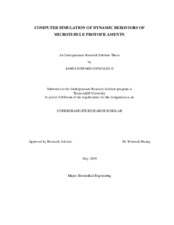| dc.description.abstract | The purpose of this study was to explore and understand the behavior of microtubule protofilaments (MT PFs) in a dynamic environment through molecular dynamics simulations. MTs play a vital role in various cellular processes such as: transport of materials within cells, cell structure and stability, and cell division. During normal cellular processes, MTs continuously polymerize and depolymerize depending on the nucleotide present in the end tubulin, either guanosine triphosphate (GTP) or guanosine diphosphate (GDP). While previous research has found that the nucleotide at the end of the filament is responsible, it is unclear why. To understand the effects of the nucleotide state, molecular dynamics simulations were performed on two different conformations of a MT PF system. One conformation contained tubulin bound only to GTP and the other conformation contained tubulin bound to both GTP and GDP. Both conformations were simulated in two different sizes, as a 2-dimer and 4-dimer MT PF, which resulted in 4 unique systems. The 2-dimer systems were simulated for 400 nanoseconds (ns), and the 4-dimer systems were simulated for 210 ns. The difference in simulation times is due to computation time limitations. The trajectories of these simulations were analyzed using a method developed in our lab, to quantify the mechanical properties of MT PFs as an elastic rod in order to easily predict the mechanical behavior of the MT PF. Additionally, an analysis of the non-polar and polar contacts found between tubulin was performed to see the chemical effect of the nucleotide state on the mechanical properties of MT PFs. It was found that the mechanical properties of a MT PF can be accurately quantified as an elastic rod. The results from our analysis showed differences in these mechanical properties between the two conformations. We believe that the specific contacts present in the tubulin interfaces are likely responsible for the changes observed in mechanical properties between the conformations. It was also found that although the bending stiffness analysis shows promising results, longer simulations need to be obtained to make definitive claims based on these properties. | en |


